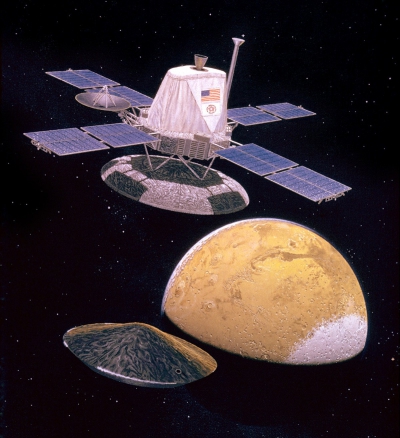The Viking 2 mission was part of the American Viking program to Mars, and consisted of an orbiter and a lander essentially identical to that of the Viking 1 mission. Viking 2 was operational on Mars for 1281 sols (1316 days; 3 years, 221 days). The Viking 2 lander operated on the surface for 1316 days, or 1281 sols, and was turned off on April 12, 1980, when its batteries failed. The orbiter worked until July 25, 1978, returning almost 16,000 images in 706 orbits around Mars.
The Viking program consisted of a pair of identical American space probes, Viking 1 and Viking 2, which landed on Mars in 1976. Each spacecraft was composed of two main parts: an orbiter designed to photograph the surface of Mars from orbit, and a lander designed to study the planet from the surface. The orbiters also served as communication relays for the landers once they touched down.
The Viking program grew from NASA's earlier, even more ambitious, Voyager Mars program, which was not related to the successful Voyager deep space probes of the late 1970s. Viking 1 was launched on August 20, 1975, and the second craft, Viking 2, was launched on September 9, 1975, both riding atop Titan IIIE rockets with Centaur upper stages. Viking 1 entered Mars orbit on June 19, 1976, with Viking 2 following on August 7.
After orbiting Mars for more than a month and returning images used for landing site selection, the orbiters and landers detached; the landers then entered the Martian atmosphere and soft-landed at the sites that had been chosen. The Viking 1 lander touched down on the surface of Mars on July 20, 1976, more than two weeks before Viking 2's arrival in orbit. Viking 2 then successfully soft-landed on September 3. The orbiters continued imaging and performing other scientific operations from orbit while the landers deployed instruments on the surface.
The project cost was roughly $1 billion at the time of launch, equivalent to about 5 billion USD in 2020 dollars. The mission was considered successful and is credited with helping to form most of the body of knowledge about Mars through the late 1990s and early 2000s.

1976Sep, 3
Viking program: The American Viking 2 spacecraft lands at Utopia Planitia on Mars.
Choose Another Date
Events on 1976
- 5Jan
Democratic Kampuchea
The Khmer Rouge proclaim the Constitution of Democratic Kampuchea. - 13Apr
Thomas Jefferson
The United States Treasury Department reintroduces the two-dollar bill as a Federal Reserve Note on Thomas Jefferson's 233rd birthday as part of the United States Bicentennial celebration. - 8May
Six Flags Magic Mountain
The rollercoaster The New Revolution, the first steel coaster with a vertical loop, opens at Six Flags Magic Mountain. - 11Oct
Gerald R. Ford
George Washington's appointment, posthumously, to the grade of General of the Armies by congressional joint resolution Public Law 94-479 is approved by President Gerald R. Ford. - 13Oct
Ebola
The first electron micrograph of an Ebola viral particle is obtained by Dr. F. A. Murphy, now at U.C. Davis, who was then working at the C.D.C.

 English
English  español
español  français
français  português
português  русский
русский  العربية
العربية  简体中文
简体中文 